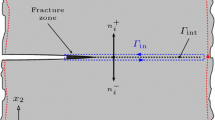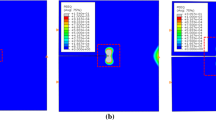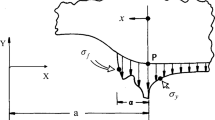Abstract
A thermo-mechanical effect from partial conversion of fracture work into heat energy during crack propagation is considered with a simple mathematical model. It is assumed that the heat production zone in the vicinity of the crack tip is very small. Thus, the crack propagation process can be viewed as propagation of the crack in elastic material with a point thermal heat source fixed at the tip of the crack. This thermal heat source generates its own temperature and stress fields around the crack tip. As shown in this paper it also generates a negative stress intensity factor that specifies fracture mode I and has to be accounted for in the energetic fracture criterion. The model developed may help to explain many experimental observations such as the increase in the specific surface energy that accompanies an increase in the crack speed and why fracture mode I has a special role in crack propagation phenomena.
Similar content being viewed by others
References
Bunting, K.A. and Gornfield, G. (1975). Toward a general theory of cutting: a relationship between the incident power density and the cut speed. Trans. of ASME, Journal of Heat Transfer 16–122.
Costanzo, F. and Walton, J.R. (1997). A study of dynamic crack growth in elastic materials using a cohesive zone model. International Journal of Engineering Science 35, 1085–1114.
Cotterell, B. (1965). On brittle fracture paths. International Journal of Fracture Mechanics 1, 96–103.
Dillon, O.W., Jr. (1963). Coupled thermoplasticity. Journal of Mechanics and Physics of Solids 11, 21–33.
Dillon, O.W., Jr. and Tauchert, T.R. (1966). The experimental technique for observing the temperature due to the coupled thermoelastic effect. International Journal of Solids and Structures 2, 385–391.
Dowling, N.E. (1993). Mechanical Behavior of Materials: Engineering Methods for Deformation, Fracture, and Fatigue. Prentice-Hall International, USA.
Craggs, J.W. (1960). On the propagation of a crack in an elastic-brittle material. Journal of the Mechanics and Physics of Solids 8, 66–76.
Engineering Materials Handbook, prepared under the direction of the ASM International Handbook Committee; Ch. Reinhart T.J. (1987–1991).
Erdogan, F., (1969). Crack-propagation theories, in Fracture. Mathematical Fundamentals (edited by H. Liebowitz), Vol. 2, pp. 497–590.
Freund, L.B. (1990). Dynamic Fracture Mechanics. Cambridge University Press, Cambridge
Fuller, K.N.G., Fox, P.G. and Field, J.E. (1975). The temperature rise at the tip of a fast-moving crack in glassy polymers. Proceedings of the Royal Society A341, 537–557.
Kanninen, M.F. (1985). Application of dynamic fracture mechanics for the prediction of crack arrest in engineering structures. International Journal of Fracture 27, 299–312.
Kotousov, A. (2000). Thermal stresses and fracture of thin plates during cutting and welding operations. International Journal of Fracture 103, 361–372.
Kotousov, A. (1999). A Thermo-Mechanical Effects Associated with Crack Propagation. International Workshop on Fracture Mechanics and Advanced Engineering Materials, December 8-10, Sydney University, Australia, 43–51.
Kumar, R.K., Narasimhan, R. and Prabhakar, O. (1991). Temperature rise in a viscoplastic material during dynamic crack growth. International Journal of Fracture 48, 23–40.
Marchand, A. and Duffy, J. (1988). An experimental study of the formation process of adiabatic shear bands in structural steel. Journal of Mechanics and Physics of Solids 36, 251–283.
Mason, J.J., Rosakis, A.J. and Ravichandran, G. (1993). On the strain and strain rate dependence of the fracture of plastic work converted into heat and full field measurements of the dynamic deformation field around a growing adiabatic shear band. Proceedings of the USA Army Symposium on Solid Mechanics.
Neimitz A. (1995). Controversies in dynamic fracture mechanics. Archives of Mechanics 47, 985–1001.
Nilsson, F. (1997). Issues in Dynamic Crack Propagation. In: Advances in Fracture Research, (ECF9), Vol. 6, pp. 2697–2706.
Nowacki, W. (1975). Distortion problems of elasticity. Application of Integral Transformations in the Theory of Elasticity (edityed by Sneddon, I.N.), Springer-Verlag, New York, 171–240.
Owen, D.M., Zhuang, S., Rosakis, A.J. and Ravichandran, G. (1998). Experimental determination of dynamic crack initiation and propagation fracture toughness in thin aluminum sheets. International Journal of Fracture 90, 153–174.
Prudnikov, A.P., Bychkov, Yu.A. and Marychev, O.I. (1983). Integrals and Series. Special Functions. Moscow.
Ravi-Chandar, K. and Knauss, W.G. (1984a-d). An experimental investigation into the mechanics of dynamic fracture - I. Crack initiation and crack arrest; II.Microstructural aspects; III. On steady-state crack propagation and branching; IV. On interaction of stress waves with propagating cracks. International Journal of Fracture 25, 247–262; 26, 65-80; 26, 141-154; 26, 186-200.
Ravi-Chandar, K. (1995). On the failure mode transition in polycarbonate under dynamic mixed-mode loading. International Journal of Solids Structures 32, 925–938.
Ravi-Chandar, K. (1998). Dynamic fracture of nominally brittle materials. International Journal of Fracture 90, 83–102.
Rose, L.R.F. (1976). Recent theoretical and experimental results on fast brittle fracture. International Journal of Fracture 12, 799–813.
Sung, J.C. and Achenbach, J.D. (1990). Heating at a propagating crack tip in a viscoplastic material. International Journal of Fracture 44, 301–309.
Taylor, G.I and Quinney, H. (1934). The latent energy remaining in a metal after cold working. Proceedings of the Royal Society A143, 307–326.
Turner, C.E. (1990). A re-assessment of ductile tearing resistance. In: Fracture Behavior and Design of Materials and Structures, (ECF 8),(edited by Firrao, C.), Vol. 1, part 1, pp. 933–940, part 2, pp. 951-968.
Weichert, R. and Schonert, K. (1978). Heat generation at the tip of a moving crack. Journal of Mechanics and Physics of Solids 26, pp. 151–161.
Zehnder, A. and Rosakis, A.J. (1991). On the Temperature distribution at the vicinity of dynamically propagating cracks in 4340 steel. Journal of the Mechanics and Physics of Solids 39, 385–415.
Zhou, M., Rosakis, A.J. and Ravichandan G. (1996). Dynamically propagating shear bands in impact-loaded prenoched plates-I. Experimental investigations of temperature signatures and propagation speed. Journal of Mechanics and Physics of Solids 44, 981–1006.
Author information
Authors and Affiliations
Rights and permissions
About this article
Cite this article
Kotousov, A. On a thermo-mechanical effect and criterion of crack propagation. International Journal of Fracture 114, 349–358 (2002). https://doi.org/10.1023/A:1015769513968
Published:
Issue Date:
DOI: https://doi.org/10.1023/A:1015769513968




